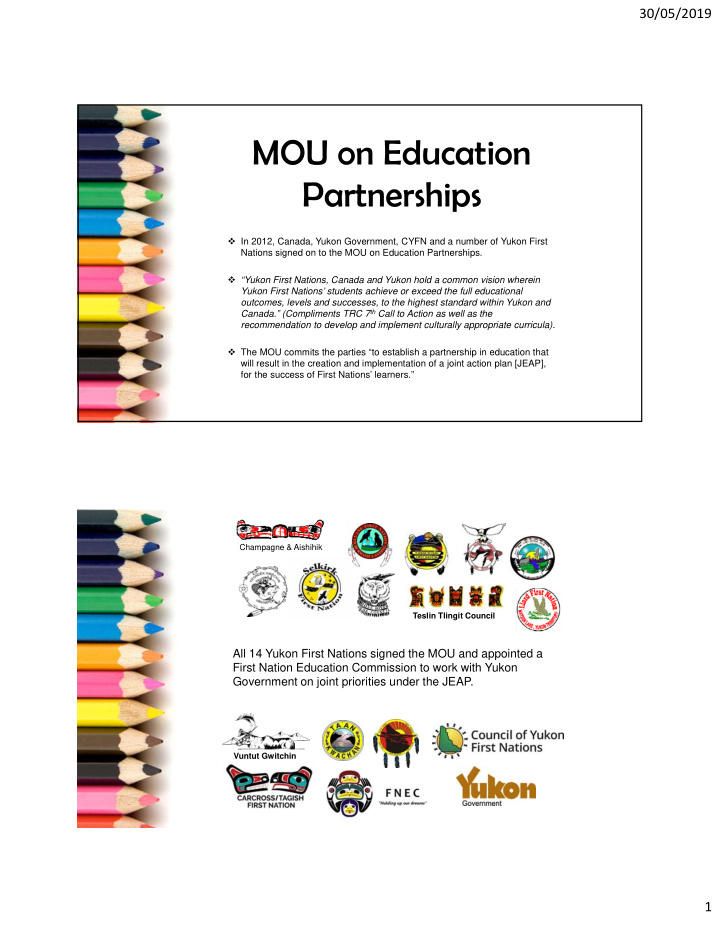



30/05/2019 MOU on Education Partnerships In 2012, Canada, Yukon Government, CYFN and a number of Yukon First Nations signed on to the MOU on Education Partnerships. “Yukon First Nations, Canada and Yukon hold a common vision wherein Yukon First Nations’ students achieve or exceed the full educational outcomes, levels and successes, to the highest standard within Yukon and Canada.” (Compliments TRC 7 th Call to Action as well as the recommendation to develop and implement culturally appropriate curricula). The MOU commits the parties “to establish a partnership in education that will result in the creation and implementation of a joint action plan [JEAP], for the success of First Nations’ learners.” Champagne & Aishihik Teslin Tlingit Council All 14 Yukon First Nations signed the MOU and appointed a First Nation Education Commission to work with Yukon Government on joint priorities under the JEAP. Vuntut Gwitchin 1
30/05/2019 Vision Our students are excelling in both worlds, rooted with fluency in their traditional language and knowledge of their culture and history, and confidently living life side by side with others, in a multi-lingual and multi-cultural Yukon society. Our students are lifelong learners and First Nation citizens that will empower the present and future generations. 2
30/05/2019 Overarching challenges: • The last JEAP Implementation Working Group meeting was November 2016. • First Nations feel that the Yukon and Federal Governments have not addressed the ‘power imbalances’: – Insufficient funding for joint priorities and initiatives – Many initiatives worked on by Yukon Government and the First Nation Education Commission from the ‘side of the desk’ – Initiatives need to be funded by Yukon Government/Canada and Yukon First Nation -driven • Yukon Government is incorporating Yukon First Nations Ways of Knowing and Doing within the schools and the school curriculum, however it has faced the following challenges: – It is implementing initiatives (including some that are identified under the JEAP Implementation Plan) with First Nation involvement, however it is acknowledged that these do not meet the Yukon Government’s commitments under the JEAP. – For some initiatives, it has been difficult to achieve consensus at a Yukon wide level about how these should be addressed. Overarching Challenges (cont’d) • Roles and responsibilities within the MOU are unclear. • Who is responsible and accountable for ensuring that joint priorities are both identified and implemented? • Who has the power and authority to make decisions? How is reporting and evaluation done? • Canada has not been at the table. • What has been done to implement the joint initiatives that have been identified? To what depth and degree? What has not been done? • Confusion around Bi-lateral Education Memorandum of Understandings/Agreements with Yukon First Nations – at the local level, they address some initiatives identified in JEAP. 3
30/05/2019 Possibilities • JEAP has not gotten us far, BUT it provides the potential to address joint priorities in a meaningful way: – All 14 Yukon First Nations, Canada and Yukon Government are signatories. – The JEAP is based on numerous reports and consultations over the course of history and is broad enough to address individual Yukon First Nation aspirations. • The problem is not the JEAP itself but our commitment to the JEAP. • We need to focus on our key joint priorities and identify funding and resources needed to achieve those priorities. Next Steps » Do we want to continue to partner on JEAP? » If so, how do we make sure that the process is effective (Implementation Working Group with clear responsibility, accountability, funding, resources and focus) » If not, what other ways are there for us to move forward together on Yukon wide joint education priorities? 4
Recommend
More recommend